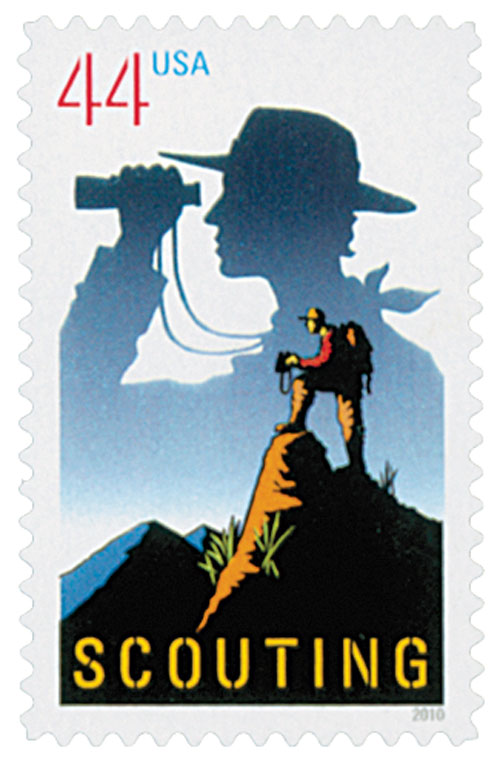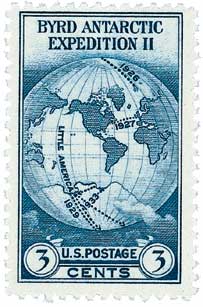
# 2389 FDC - 1988 25c Antarctic Explorers: Lincoln Ellsworth
25¢ Lincoln Ellsworth
Antarctic Explorers
City: Washington, DC
Quantity: 40,535,625
Printed By: American Bank Note Co
Printing Method: Photogravure
Perforations: 11
Color: Multicolored
Polar explorer Lincoln Ellsworth was born on May 12, 1880, in Chicago, Illinois. He was the first person to fly over both polar regions, which earned him two Congressional Gold Medals. He’s one of just four people to have received two of the prestigious medals. The son of a wealthy coal-mine owner, Ellsworth enjoyed the outdoors from a young age, hiking through the wilderness any chance he got. Ellsworth attended the Sheffield Scientific School at Yale and later Columbia and McGill Universities. In 1903, he was hired to stake out a railway in the Canadian wilderness. The experience was life-changing. As Ellsworth recalled, “I changed from a pale college youth to a tough and weather-beaten outdoor man.” Over the next few years, Ellsworth worked as a chief engineer at a gold mine in Alaska and staked out another railway there. During this time, he helped establish the town of Prince Rupert and studied railway engineering and practical astronomy. Ellsworth set his sights on scientific expeditions. With all the news of polar expeditions – Frederick Cook and Robert E. Peary claiming to reach the North Pole in 1908 and 1909, and Roald Amundsen traveling to the South Pole in 1912 – Ellsworth grew fascinated with the idea. He studied geographical surveying at the Royal Geographical Society in London and worked as an assistant for the US Biological Survey, going on expeditions to California, British Columbia, and Mexico. In 1916, Ellsworth volunteered to fly for France during World War I, though he was assigned to an office. However, the experience did afford him the opportunity to meet Roald Amundsen, though he didn’t have a place for him in his upcoming expedition. When they met again in 1924, Amundsen invited him to join his expedition to the North Pole. He served as navigator and they departed by flying boat on May 21, 1925, reaching their destination after eight-and-a-half hours. They spent over three weeks building an air strip to take off for their return flight. They launched a second expedition the following year during which they flew over the North Pole on Ellsworth’s birthday. In 1927, the Boy Scouts made Ellsworth an Honorary Scout, given to “American citizens whose achievements in outdoor activity, exploration and worthwhile adventure are of such an exceptional character as to capture the imagination of boys.” Then in 1928, he was awarded the Congressional Gold Medal for his two expeditions to the north. By the late 1920s, Ellsworth felt he was done with Arctic exploration and spent time in the Grand Canyon and Death Valley searching for fossilized algae. He participated in a failed expedition of the submarine Nautilus to the North Pole. In 1931, he joined in a zeppelin expedition to Taymyr, Russia as an arctic expert. The experience renewed his interest in polar exploration, and he turned his attention to the Antarctic. In 1933, Ellsworth launched his first Antarctic expedition by air, to explore whether Amundsen’s Queen Maud Mountain Range was part of the mountains in the Antarctic Peninsula. Ellsworth bought a Norwegian ship and named it after his childhood hero, Wyatt Earp. Along the way, the ship was badly damaged by sea ice and they had to wait for repairs. Their renewed efforts in 1934 were also unsuccessful because of technical issues and poor weather. Ellsworth embarked on another expedition in November 1935 with pilot Herbert Hollick-Kenyon. Between November 22 and December 5, they flew nearly 2,300 miles, the longest transantarctic flight until 1956. They had traveled further into Antarctica than any expedition before them. However, rough weather forced them from the air several times and their plane eventually ran out of gas. Due to a faulty radio, they were unable to inform anyone of their situation and walked 16 miles to the Little America station set up by Richard Byrd in 1929. They were declared missing and rescue ships were sent to retrieve them. They were rescued on January 15.Birth of Lincoln Ellsworth






Ellsworth received the National Geographic Society’s Hubbard Medal in 1936. He also became one of only four people to receive a second Congressional Gold Medal. Ellsworth returned to Antarctica again in 1938 and planned more trips, but these were called off because of World War II. He suffered a bad fall on a trek in Mexico in 1943 and died on May 26, 1951.
25¢ Lincoln Ellsworth
Antarctic Explorers
City: Washington, DC
Quantity: 40,535,625
Printed By: American Bank Note Co
Printing Method: Photogravure
Perforations: 11
Color: Multicolored
Polar explorer Lincoln Ellsworth was born on May 12, 1880, in Chicago, Illinois. He was the first person to fly over both polar regions, which earned him two Congressional Gold Medals. He’s one of just four people to have received two of the prestigious medals. The son of a wealthy coal-mine owner, Ellsworth enjoyed the outdoors from a young age, hiking through the wilderness any chance he got. Ellsworth attended the Sheffield Scientific School at Yale and later Columbia and McGill Universities. In 1903, he was hired to stake out a railway in the Canadian wilderness. The experience was life-changing. As Ellsworth recalled, “I changed from a pale college youth to a tough and weather-beaten outdoor man.” Over the next few years, Ellsworth worked as a chief engineer at a gold mine in Alaska and staked out another railway there. During this time, he helped establish the town of Prince Rupert and studied railway engineering and practical astronomy. Ellsworth set his sights on scientific expeditions. With all the news of polar expeditions – Frederick Cook and Robert E. Peary claiming to reach the North Pole in 1908 and 1909, and Roald Amundsen traveling to the South Pole in 1912 – Ellsworth grew fascinated with the idea. He studied geographical surveying at the Royal Geographical Society in London and worked as an assistant for the US Biological Survey, going on expeditions to California, British Columbia, and Mexico. In 1916, Ellsworth volunteered to fly for France during World War I, though he was assigned to an office. However, the experience did afford him the opportunity to meet Roald Amundsen, though he didn’t have a place for him in his upcoming expedition. When they met again in 1924, Amundsen invited him to join his expedition to the North Pole. He served as navigator and they departed by flying boat on May 21, 1925, reaching their destination after eight-and-a-half hours. They spent over three weeks building an air strip to take off for their return flight. They launched a second expedition the following year during which they flew over the North Pole on Ellsworth’s birthday. In 1927, the Boy Scouts made Ellsworth an Honorary Scout, given to “American citizens whose achievements in outdoor activity, exploration and worthwhile adventure are of such an exceptional character as to capture the imagination of boys.” Then in 1928, he was awarded the Congressional Gold Medal for his two expeditions to the north. By the late 1920s, Ellsworth felt he was done with Arctic exploration and spent time in the Grand Canyon and Death Valley searching for fossilized algae. He participated in a failed expedition of the submarine Nautilus to the North Pole. In 1931, he joined in a zeppelin expedition to Taymyr, Russia as an arctic expert. The experience renewed his interest in polar exploration, and he turned his attention to the Antarctic. In 1933, Ellsworth launched his first Antarctic expedition by air, to explore whether Amundsen’s Queen Maud Mountain Range was part of the mountains in the Antarctic Peninsula. Ellsworth bought a Norwegian ship and named it after his childhood hero, Wyatt Earp. Along the way, the ship was badly damaged by sea ice and they had to wait for repairs. Their renewed efforts in 1934 were also unsuccessful because of technical issues and poor weather. Ellsworth embarked on another expedition in November 1935 with pilot Herbert Hollick-Kenyon. Between November 22 and December 5, they flew nearly 2,300 miles, the longest transantarctic flight until 1956. They had traveled further into Antarctica than any expedition before them. However, rough weather forced them from the air several times and their plane eventually ran out of gas. Due to a faulty radio, they were unable to inform anyone of their situation and walked 16 miles to the Little America station set up by Richard Byrd in 1929. They were declared missing and rescue ships were sent to retrieve them. They were rescued on January 15.Birth of Lincoln Ellsworth






Ellsworth received the National Geographic Society’s Hubbard Medal in 1936. He also became one of only four people to receive a second Congressional Gold Medal. Ellsworth returned to Antarctica again in 1938 and planned more trips, but these were called off because of World War II. He suffered a bad fall on a trek in Mexico in 1943 and died on May 26, 1951.













